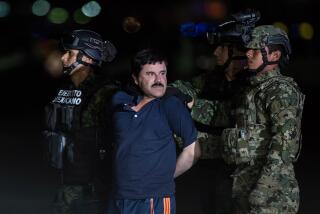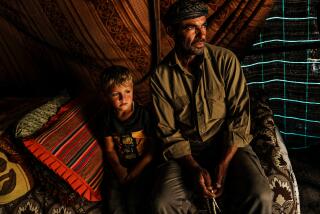The Resurgence of Warlords Is Sign of the ‘90s
- Share via
New World Order? The Global Age? Decade of Uncertainty?
None of the labels stuck. But now the nameless ‘90s can be baptized at last, at the point of a gun: It’s the Time of the Warlords.
Not the snarly rock group or the computer game or some helmeted comic-book warriors, but the real-life characters--self-styled generals and self-anointed presidents--who strut and struggle over territories in turmoil, from Africa’s savannah to Afghanistan’s snowy Hindu Kush to the jungles of Southeast Asia.
They’re a motley collection: a U.S. prison escapee and an ex-Marine; an ice cream magnate; opium traffickers; a diamond-market manipulator.
More and more, these regional strongmen in smartly pressed fatigues have been commanding the headlines and confounding the peacemakers.
The latest incarnation may soon appear in the bush of eastern Zaire, where a newborn rebel army under Laurent Kabila reportedly has captured the gold mines of Kamituga, the kind of resource that can make a warrior a warlord.
The warlord’s habitat is a vacuum--the collapse of central authority. His ideology seldom ventures beyond the mercenary.
Dictionaries define the term as “a military commander exercising civil power by force, usually in a limited area.” But history provides a little more insight.
The term gained currency in the 1920s in China, describing regional military chiefs who sliced up that huge but weak land into lucrative fiefdoms.
“The whole warlord system is based on the interception of national revenue at the points where it is levied and on nothing else,” British journalist Putnam Weale reported at the time.
Weale would recognize the heirs of those single-minded Chinese “junfa.”
In stylish sunglasses and armored limousines, ringed by retinues of hard-eyed young men hugging Kalashnikovs, warlords today appear daily on front pages and TV screens around the world. But their business--milking their fiefdoms for what they can get--is the same as in the days before satellite hookups.
“The more accurate term may be mafias,” said political scientist William Reno, whose book “Warlord Politics and African States” is nearing completion. “What fuels it all is young men who have aspirations and no economic prospects whatsoever.”
What fuels it as well is the end of the Cold War.
When the U.S. and Soviet superpowers stopped propping up Third World national leaders with aid and weapons, factions fell to fighting over what was left, in such places as Somalia, Liberia and Afghanistan. The result, a U.N. report says, was often “gangster territories.”
The leading figures in this warlords’ world are a varied lot:
Rashid Dostum
In his camouflage uniform, thick mustache and imposing bulk, Dostum is a familiar sight as he lords it over a large chunk of northern Afghanistan.
The onetime union boss and ex-government general now leads an Uzbek ethnic army of 50,000 men, holdouts against the nationwide sweep to power by the Islamic zealots of the Taliban movement.
Through years of Afghan warfare, this master of maneuver flip-flopped his allegiance repeatedly among Communist and Islamic factions, preserving his power base.
He grew rich taxing the local bazaar trade with Central Asian republics, started his own airline, and commands a private air force. From his mud-walled fort, he rules with the authority of a pasha--the antique title his followers bestow on him.
Charles Taylor
In the 1980s, Liberian President Samuel Doe kept ambitious lieutenants in line by passing along the fruits of U.S. aid. When the money stopped in 1989, civil war broke out. More than 150,000 people were killed, Doe among them.
The U.S.-educated Taylor, onetime government procurement chief, emerged as the strongest of half a dozen warlords, each with his own territory, commercial interests, loyal teenage soldiers and reputation for atrocity.
Taylor profited from diamond smuggling out of neighboring Sierra Leone and rake-offs from foreign companies. A British mining firm paid millions to ship iron ore from his region.
Under a shaky peace agreement, Taylor convoys around Monrovia, the capital, in a gold all-terrain vehicle and issues pronouncements via his private radio station, KISS-FM.
He won’t soon return to the United States. He’s wanted here for a prison escape in 1989 while being held for extradition to Liberia on embezzlement charges.
Hussein Aidid
Some achieve warlordship. Others have it thrust upon them.
Aidid’s father, Gen. Mohammed Farrah Aidid, was the prototype of the African warlord in 1992, when his militiamen blocked, stole or skimmed off their share from food shipments meant for Somalia’s starving people.
Since then, Somalia’s clan wars have subsided only slightly. In a battle in August, the elder Aidid was fatally wounded, and his Habre Gedir clan turned to the 34-year-old son to take command of its southern stronghold.
The succession was ironic. Hussein Aidid, a naturalized U.S. citizen, served as a Marine interpreter during the 1992-93 U.S. military operation in Somalia, which climaxed in bloody clashes between the Americans and his father’s gunmen.
“Foreign involvement” is Somalia’s biggest problem, the younger Aidid now says. But international aid is, of course, still welcome.
Zeljko Raznatovic
He doesn’t control a ministate in typical warlord fashion. But the infamous Serbian militia leader known as “Arkan” has profited from war in lordly style.
In the bloody breakup of Yugoslavia, the Belgrade ice cream parlor owner became one of Serbia’s richest men, reputedly through the currency black market, oil smuggling and arms dealing. His 1,000-man “Tigers” militia, meanwhile, became known for savagery.
The rap sheet on the boyish-faced Raznatovic begins long before the war. He is wanted for bank robberies in Western Europe in the 1970s and 1980s.
Jonas Savimbi
Angola’s 1992 elections were to cement peace after 17 years of civil war. But Savimbi, a loser at the polls, rejected the results and took his UNITA rebels back into action, seizing a northern diamond-mining region. Soon the huge UNITA output, smuggled out of the country, unsettled the international diamond market.
Savimbi, who favors jungle fatigues and pearl-handled revolvers, presents his cause as a fight for justice for Angola’s Ovimbundu people. The United States long supported him as an anti-Communist force in Africa. But others increasingly see the ideology of the black market.
“UNITA is as much a diamond-mining operation as an ethnic uprising,” said Reno, a Florida International University scholar.
Ex-Soviets
The demise of the Soviet Union was the dawn of opportunity for aspiring warlords.
In the new Republic of Georgia, the paramilitary “Horsemen” of ex-convict Dzhaba Ioseliani helped unseat one president and install another, and set up territories for their own businesses. In Tajikistan, clan-based warlords have alternately propped up and threatened a weak government. Russia’s Chechnya, meanwhile, became a haven for international Chechen mafias under secessionist leader Dzokhar Dudayev.
But with opportunity comes danger. Ioseliani now sits in a Georgian jail, accused of a presidential assassination attempt. And Dudayev was reported killed in April in the war with Russia--although disbelieving Chechen faithful insist that he is alive and will return.
Ta Mok
In their long guerrilla war in Cambodia, the radical Khmer Rouge built profitable smuggling networks for timber and gems. Recently, their dwindling bands have turned to banditry.
Ta Mok, an infamous commander from the Khmer Rouge’s genocidal days of the 1970s, is one defiant holdout, dug in at remote Anlong Veng. The one-legged guerrilla chief announced his “retirement” seven years ago, but the tug of the warlord’s life apparently has proved too strong.
Khun Sa
Khun Sa, on the other hand, showed you can start anew.
The notorious opium warlord and thousands of his soldiers from Myanmar’s lawless Shan state “surrendered” to the government in January 1996. Soon after, say U.S. drug authorities, he was operating through 10 front companies in Yangon, the capital.
While younger “generals” vie for opium supremacy back home in Shan, Khun Sa is branching out. He was recently given a government contract to run inter-city buses.
*
The warlord’s career can be a dead end, Reno said.
“Ultimately, these guys can’t get very far in business,” he said. “Until you become the president of a republic, you have no credit worthiness. When you’re president, you have a seat in the U.N., international bank credit, bilateral aid, these kinds of things.”
A glance at Lebanon’s new Cabinet tells you warlords know that.
A few years after a lethal array of militia chiefs, each with his own slice of territory, rampaged across that tiny land, one now runs the Health Ministry (Suleiman Franjieh) and another Refugee Affairs (Walid Jumblatt). And Elie Hobeika, identified as author of one of the civil war’s great atrocities, the massacre of Palestinians in Beirut, now oversees the multimillion-dollar reconstruction of Lebanon’s electrical and water systems.
Warlords worried about getting ahead might take some advice from the father of them all, in “Leadership Secrets of Attila the Hun.”
“Chieftains should always aim high,” the old pillager counsels in the recent fanciful book. “Focus on opportunities, rather than on problems.”
More to Read
Sign up for Essential California
The most important California stories and recommendations in your inbox every morning.
You may occasionally receive promotional content from the Los Angeles Times.










